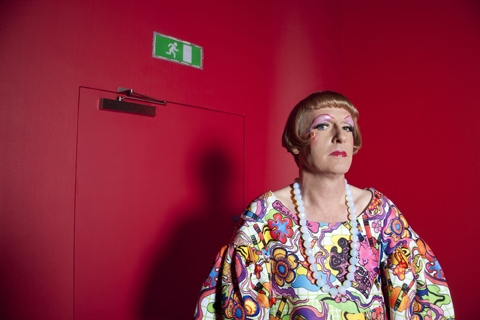“It’s about time a transvestite potter won the Turner Prize,” quipped Grayson Perry when he accepted the Tate’s annual best-artist prize back in 2003. In the decade since, Perry has become a media celebrity and public figure, turning his hand to television appearances and newspaper criticism, and, in his well received 2012 documentary series All in the Best Possible Taste with Grayson Perry, taking on the subject of social class and taste among the cultural ‘tribes’ of contemporary Britain.
Perry’s affable, tolerant, sceptical public persona has made him an unusual, but somehow appropriate candidate to be anointed as the British artworld’s next establishment figure, at a time when the media glow surrounding the previously media-friendly controversialism of the YBAs has cooled.
Perry’s lectures presented a wholly institutional notion of contemporary art, in which content and function were pretty much secondary to the machinery of the ‘artworld’ itself
Awarded the title of CBE (Commander of the Order of the British Empire) in the Queen’s Birthday Honours last June, Perry was this autumn given the prestigious task of presenting the BBC’s Reith Lectures – the national broadcaster’s annual public showcase for important debates on society, politics and the arts, delivered by one or other leading figure in their specialism.
Perry joins the august ranks of Reith lecturers such as Aung San Suu Kyi and Bertrand Russell. Perry is also the first practising artist to present the Reith Lectures. So, dressed as his alter-ego, Claire, in front of a packed audience at Tate Modern, he set out his task to try to reconcile the broader public with contemporary art; to answer those questions people ask “when they go into a gallery and are slightly bemused or maybe angered by the work”, and to “help them – give them tools to understand and appreciate art”.
Perry wanted to help answer the thorny questions: “How do we know when something is good? Who tells us, and does it really matter?” As it turned out, Perry never got near to answering these questions. In fact, what was interesting about Perry’s lectures was that they presented a completely empty, wholly institutional notion of contemporary art, in which its content and function were pretty much secondary to the machinery of the ‘artworld’ itself.
So in the first lecture, rather than risk asserting some idea of what might still function as a criterion of value in art, Perry quickly drifted into explaining that what gave value to art were the myriad operations of “validation” that occurred between collectors, dealers and curators (not so much critics). In other words, it’s good because, er, these people say it is.
By the second lecture, Perry was grappling with what was or wasn’t art, attempting to “beat the bounds” of what constituted an artwork, in an age when, apparently in the wake of Duchamp, “anything goes”. Again, Perry’s definitions were purely institutional: is it in a gallery? Is it mass-produced or limited in production? Is it a “boring version” of some other form of culture? Is it being looked at by “hipsters” or the wives of “Russian oligarchs”? In other words, it’s art because, er, it isn’t anything else.
By lecture three, Perry was declaring that we are in the “end state of art”, constituted by the redundancy of artistic rebellion and the passing of the “age of manifestos”. Quoting approvingly the recently deceased Arthur C. Danto (Perry’s only intellectual compass, it seemed) that “in the age of pluralism we have a model of tolerant multiculturalism”, Perry asked, “Wouldn’t it be wonderful to believe that the pluralistic artworld of the historical present was a harbinger for a political situation of things to come?”
And in the closing lecture, Perry made a personal and emotional case for art as the authentic space for inner expression – hopefully not too tainted by the “self-consciousness” of an artistic training, and of the “artworld”. For all their strangely vacuous self-regard and jovial, droning circularity, Perry’s lectures nevertheless encapsulated something of the current predicament of contemporary art in the public sphere. Criteria, manifestos, definitions, values – all these things are too disruptive, too divisive, too associated with conflict. And who wants all that?
Conflict, in a culture that doesn’t have much enthusiasm for determining what is right or wrong, good or bad, can only be a dangerous thing. Better to be reconciled, pluralistic and tolerant. Sincere, individual expression, playing mildly inside the machinery of the ‘artworld’, is all one should aspire to. Perry turns out to be the perfect figurehead for the relaxed, fatigued, diminished role of contemporary art in today’s public culture.
An art whose participants no longer argue for any idea of artistic values or criteria, nor even for its social function to surprise, challenge or change. A culture, in fact, that stakes no great claim to the public’s attention, but still hangs around, uncertain of whether it should get its coat. But while it’s still there, everyone can come in, and there’s nothing to be afraid of, because in the end, it doesn’t really matter.
This article was first published in the December 2013 issue.
